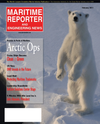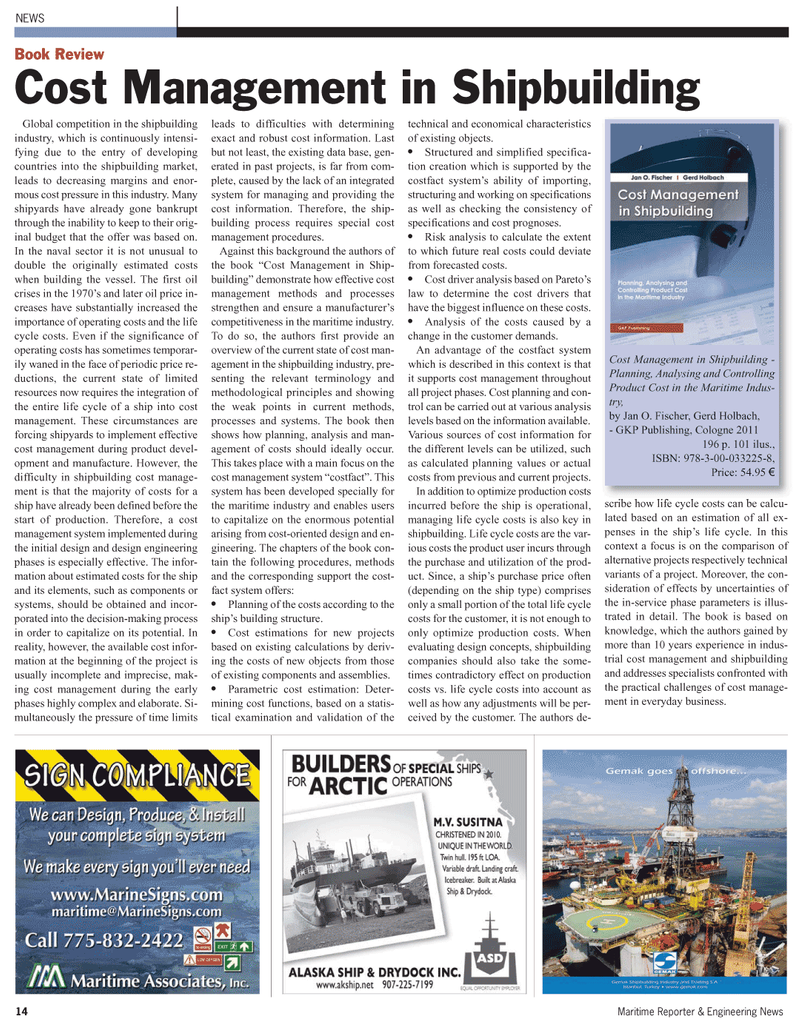
Page 14: of Maritime Reporter Magazine (February 2011)
Cruise & Passenger Vessel Annual
Read this page in Pdf, Flash or Html5 edition of February 2011 Maritime Reporter Magazine
14 Maritime Reporter & Engineering News
Global competition in the shipbuilding industry, which is continuously intensi- fying due to the entry of developing countries into the shipbuilding market, leads to decreasing margins and enor- mous cost pressure in this industry. Many shipyards have already gone bankrupt through the inability to keep to their orig- inal budget that the offer was based on.
In the naval sector it is not unusual to double the originally estimated costs when building the vessel. The first oil crises in the 1970’s and later oil price in- creases have substantially increased the importance of operating costs and the life cycle costs. Even if the significance of operating costs has sometimes temporar- ily waned in the face of periodic price re- ductions, the current state of limited resources now requires the integration of the entire life cycle of a ship into cost management. These circumstances are forcing shipyards to implement effective cost management during product devel- opment and manufacture. However, the difficulty in shipbuilding cost manage- ment is that the majority of costs for a ship have already been defined before the start of production. Therefore, a cost management system implemented during the initial design and design engineering phases is especially effective. The infor- mation about estimated costs for the ship and its elements, such as components or systems, should be obtained and incor- porated into the decision-making process in order to capitalize on its potential. In reality, however, the available cost infor- mation at the beginning of the project is usually incomplete and imprecise, mak- ing cost management during the early phases highly complex and elaborate. Si- multaneously the pressure of time limits leads to difficulties with determining exact and robust cost information. Last but not least, the existing data base, gen- erated in past projects, is far from com- plete, caused by the lack of an integrated system for managing and providing the cost information. Therefore, the ship- building process requires special cost management procedures.
Against this background the authors of the book “Cost Management in Ship- building” demonstrate how effective cost management methods and processes strengthen and ensure a manufacturer’s competitiveness in the maritime industry.
To do so, the authors first provide an overview of the current state of cost man- agement in the shipbuilding industry, pre- senting the relevant terminology and methodological principles and showing the weak points in current methods, processes and systems. The book then shows how planning, analysis and man- agement of costs should ideally occur.
This takes place with a main focus on the cost management system “costfact”. This system has been developed specially for the maritime industry and enables users to capitalize on the enormous potential arising from cost-oriented design and en- gineering. The chapters of the book con- tain the following procedures, methods and the corresponding support the cost- fact system offers: • Planning of the costs according to the ship’s building structure. • Cost estimations for new projects based on existing calculations by deriv- ing the costs of new objects from those of existing components and assemblies. • Parametric cost estimation: Deter- mining cost functions, based on a statis- tical examination and validation of the technical and economical characteristics of existing objects. • Structured and simplified specifica- tion creation which is supported by the costfact system’s ability of importing, structuring and working on specifications as well as checking the consistency of specifications and cost prognoses. • Risk analysis to calculate the extent to which future real costs could deviate from forecasted costs. • Cost driver analysis based on Pareto’s law to determine the cost drivers that have the biggest influence on these costs. • Analysis of the costs caused by a change in the customer demands.
An advantage of the costfact system which is described in this context is that it supports cost management throughout all project phases. Cost planning and con- trol can be carried out at various analysis levels based on the information available.
Various sources of cost information for the different levels can be utilized, such as calculated planning values or actual costs from previous and current projects.
In addition to optimize production costs incurred before the ship is operational, managing life cycle costs is also key in shipbuilding. Life cycle costs are the var- ious costs the product user incurs through the purchase and utilization of the prod- uct. Since, a ship’s purchase price often (depending on the ship type) comprises only a small portion of the total life cycle costs for the customer, it is not enough to only optimize production costs. When evaluating design concepts, shipbuilding companies should also take the some- times contradictory effect on production costs vs. life cycle costs into account as well as how any adjustments will be per- ceived by the customer. The authors de- scribe how life cycle costs can be calcu- lated based on an estimation of all ex- penses in the ship’s life cycle. In this context a focus is on the comparison of alternative projects respectively technical variants of a project. Moreover, the con- sideration of effects by uncertainties of the in-service phase parameters is illus- trated in detail. The book is based on knowledge, which the authors gained by more than 10 years experience in indus- trial cost management and shipbuilding and addresses specialists confronted with the practical challenges of cost manage- ment in everyday business.
NEWS
Cost Management in Shipbuilding -
Planning, Analysing and Controlling
Product Cost in the Maritime Indus- try, by Jan O. Fischer, Gerd Holbach, - GKP Publishing, Cologne 2011 196 p. 101 ilus.,
ISBN: 978-3-00-033225-8,
Price: 54.95 €
Book Review
Cost Management in Shipbuilding

 13
13

 15
15
